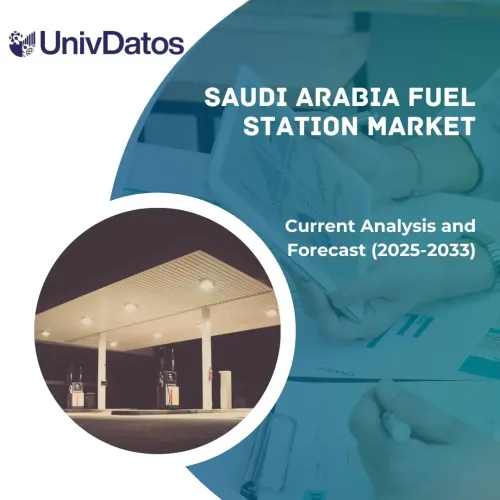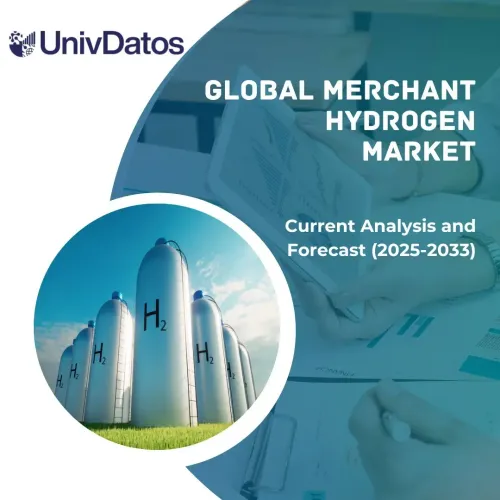Рынок гидроэнергетики: текущий анализ и прогноз (2023-2030)
Акцент на собственности (государственная и частная); технологии (водохранилища, гидроаккумулирующие электростанции и другие); мощность (менее 100 МВт, 100-500 МВт и более 500 МВт); регион/страна.
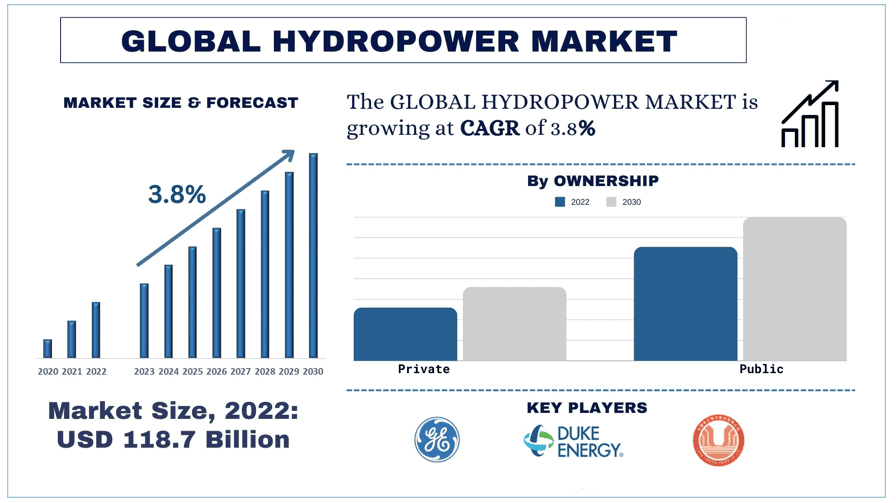
Размер и прогноз развития рынка гидроэнергетики
Объем рынка гидроэнергетики оценивался в 118,7 млрд долларов США, и ожидается, что в течение прогнозируемого периода (2023-2030 гг.) он будет расти с высокими среднегодовыми темпами роста (CAGR) около 3,8% благодаря росту инвестиций в возобновляемые источники энергии.
Анализ рынка гидроэнергетики
Гидроэнергетика, также известная как гидроэлектроэнергия, является одним из старейших и наиболее значимых источников возобновляемой энергии в мире. Используя естественный поток движущейся воды для выработки электроэнергии, гидроэнергетика играет решающую роль в энергетическом ландшафте. В настоящее время на гидроэнергетику приходится значительная часть производства возобновляемой электроэнергии во всем мире, причем только в Соединенных Штатах на нее приходится около 28,7% всей возобновляемой электроэнергии и 6,2% общего объема производства электроэнергии.
Универсальность гидроэнергетики поразительна: от крупных объектов, таких как плотина Гувера, до небольших установок на муниципальных водопроводных сооружениях или ирригационных канавах. Гибкость гидроэнергетических установок является ключевым преимуществом в интеграции других возобновляемых источников, таких как ветер и солнце, что потенциально позволяет ввести в эксплуатацию значительные новые мощности к 2035 году. Кроме того, экономическая эффективность гидроэнергетики является выдающейся особенностью: счета за электроэнергию ниже, поскольку гидроэнергетика в значительной степени зависит от минимальных эксплуатационных расходов и затрат на техническое обслуживание в течение срока службы проекта. Помимо производства электроэнергии, гидроэнергетика предлагает дополнительные преимущества, такие как борьба с наводнениями, поддержка ирригации и водоснабжение, что делает ее многогранным и важным компонентом глобального энергетического баланса.
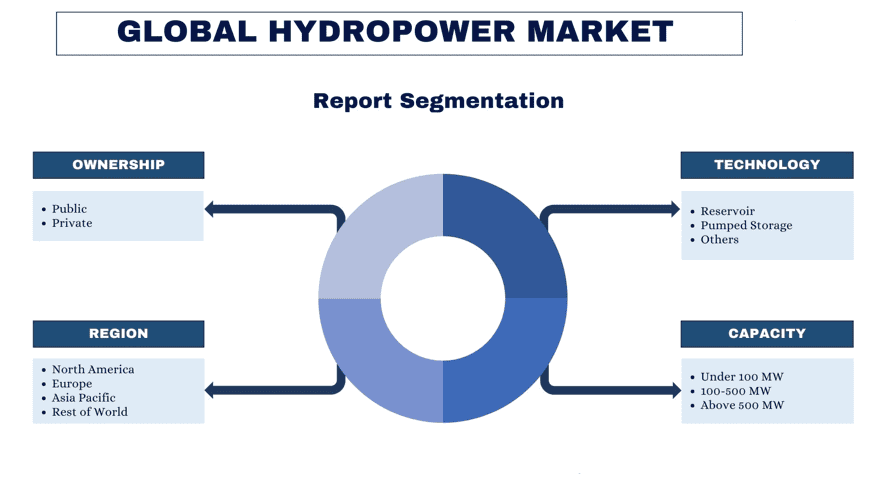
Тенденции рынка гидроэнергетики
В этом разделе обсуждаются основные тенденции рынка, которые влияют на различные сегменты рынка гидроэнергетики, как это определено нашей командой экспертов-исследователей.
Аккумулирующая гидроэнергетика
Сегмент водохранилищ приобрел большую долю на рынке гидроэнергетики, и ожидается, что аккумулирование энергии продемонстрирует значительные темпы роста в течение прогнозируемого периода. Аккумулирующая гидроэнергетика (PSH) является важной формой хранения гидроэлектроэнергии, которая играет решающую роль в энергетическом секторе. Эта инновационная технология включает в себя конфигурацию из двух резервуаров для воды на разных высотах, функционирующих как гигантская батарея, сохраняя и высвобождая энергию по мере необходимости. Аккумулирование энергии действует как динамическое решение для хранения энергии, помогая сбалансировать электросеть за счет соответствия колебаниям спроса на энергию. Это возобновляемый и чистый источник энергии, который вносит вклад в борьбу с изменением климата. Эта технология предлагает многочисленные преимущества, включая гибкость, доступность, создание рабочих мест, борьбу с наводнениями, поддержку ирригации и возможности для отдыха.
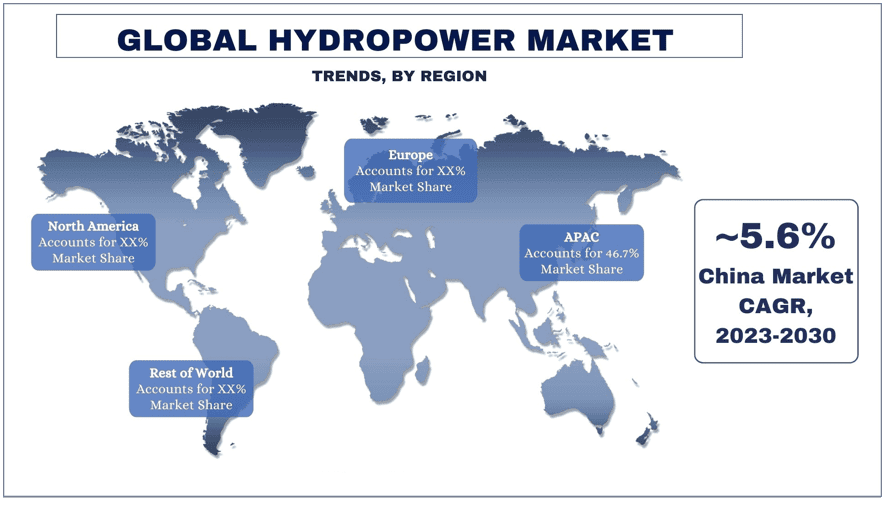
Ожидается, что Азиатско-Тихоокеанский регион будет расти со значительным среднегодовым темпом роста в течение прогнозируемого периода
Азиатско-Тихоокеанский регион зарегистрировал самую высокую долю рынка гидроэнергетики, и ожидается, что в прогнозируемый период он продемонстрирует значительный среднегодовой темп роста. Регион, охватывающий такие страны, как Китай, Индия и Япония, находится в авангарде расширения гидроэнергетики, со значительными инвестициями и достижениями как в традиционных, так и в аккумулирующих технологиях гидроэнергетики.
Китай, как мировой лидер в гидроэнергетике, взял на себя значительные обязательства по увеличению своих гидроэнергетических мощностей, планируя значительно расширить мощности аккумулирующих гидроэлектростанций к 2030 году. Сюда входит впечатляющая гидроэлектростанция Baihetan, один из крупнейших в мире проектов такого рода. Поскольку страны Азиатско-Тихоокеанского региона продолжают инвестировать в модернизацию существующих гидроэлектростанций и строительство новых проектов, все больше внимания уделяется устойчивости, вовлечению населения и охране окружающей среды. Приверженность региона использованию силы воды для производства чистой энергии не только способствует достижению глобальных целей в области чистой энергии, но и создает возможности для трудоустройства, стимулирует местную экономику и повышает общую устойчивость энергетики. Благодаря постоянному развитию технологий и сильной ориентации на инновации Азиатско-Тихоокеанский регион готов возглавить глобальное развитие гидроэнергетики для более чистого и устойчивого будущего.
Обзор отрасли гидроэнергетики
Рынок гидроэнергетики является конкурентным и фрагментированным, на нем присутствует несколько глобальных и международных игроков. Ключевые игроки применяют различные стратегии роста для расширения своего присутствия на рынке, такие как партнерства, соглашения, сотрудничество, запуск новых продуктов, географическая экспансия, слияния и поглощения. К основным игрокам, работающим на рынке, относятся Siemens AG, General Electric, China Yangtze Power, Voith Group, Andritz Hydro¸ China Three Gorges Corp, Duke Energy, Statkraft UK Ltd., Electricite de France SA и Enel SpA.
Новости рынка гидроэнергетики
- Ноябрь 2023 г.: Компания GE Vernova Hydro Power была выбрана Tacoma Power для восстановления двух турбогенераторных установок мощностью 27 МВт/33 МВА на гидроэлектростанции Cushman II из трех установок, установленных на площадке. Объем работ включает проектирование, изготовление, восстановление, установку и ввод в эксплуатацию двух новых статоров генераторов и восстановление полюсов ротора генератора, опорного подшипника вала, а также двух новых распределителей турбин и восстановление рабочего колеса турбины и отсасывающей трубы.
- Июль 2022 г.: GE вводит в эксплуатацию гидропроект Bajoli мощностью 180 МВт в Химачал-Прадеше. Проект уже подключен к сети, и каждая из трех установок мощностью 60 МВт вырабатывает электроэнергию. Объект поставляет гидроэнергию в международный аэропорт имени Индиры Ганди в Дели, который недавно стал первым в Индии аэропортом, полностью работающим на гидро- и солнечной энергии.
Отчет об охвате рынка гидроэнергетики
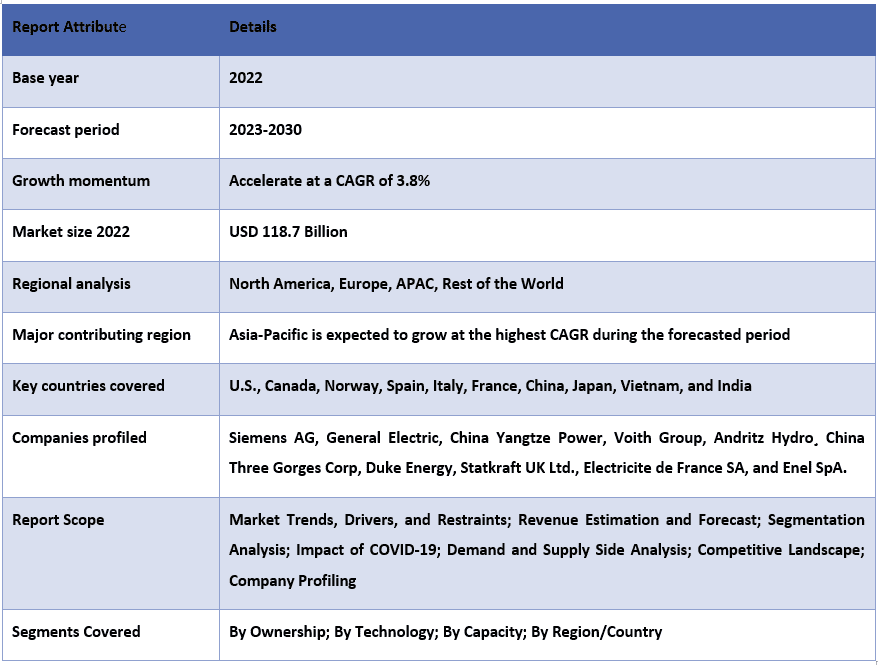
Причины купить этот отчет:
- Исследование включает анализ размера рынка и прогнозирования, подтвержденный аутентифицированными ключевыми экспертами отрасли.
- Отчет представляет собой краткий обзор общих показателей отрасли с первого взгляда.
- Отчет охватывает углубленный анализ видных игроков отрасли с основным акцентом на ключевые финансовые показатели бизнеса, портфели продуктов, стратегии расширения и последние разработки.
- Подробное изучение драйверов, ограничений, ключевых тенденций и возможностей, преобладающих в отрасли.
- Исследование всесторонне охватывает рынок по различным сегментам.
- Углубленный анализ отрасли на региональном уровне.
Варианты настройки:
Глобальный рынок гидроэнергетики может быть дополнительно настроен в соответствии с требованиями или любым другим сегментом рынка. Кроме того, UMI понимает, что у вас могут быть свои собственные бизнес-потребности, поэтому не стесняйтесь связаться с нами, чтобы получить отчет, который полностью соответствует вашим требованиям.
Содержание
Методология исследования анализа рынка гидроэнергетики (2023-2030 гг.)
Анализ исторического рынка, оценка текущего рынка и прогнозирование будущего рынка глобального рынка гидроэнергетики были тремя основными шагами, предпринятыми для создания и анализа внедрения гидроэнергетики в основных регионах мира. Было проведено исчерпывающее вторичное исследование для сбора исторических рыночных показателей и оценки текущего размера рынка. Во-вторых, для подтверждения этих данных были приняты во внимание многочисленные выводы и предположения. Кроме того, были проведены исчерпывающие первичные интервью с экспертами отрасли по всей цепочке создания стоимости глобального рынка гидроэнергетики. После принятия и проверки рыночных показателей посредством первичных интервью мы использовали подход "сверху вниз/снизу вверх" для прогнозирования общего размера рынка. После этого были приняты методы декомпозиции рынка и триангуляции данных для оценки и анализа размера рынка сегментов и подсегментов отрасли. Подробная методология описана ниже:
Анализ исторического размера рынка
Шаг 1. Углубленное изучение вторичных источников:
Было проведено подробное вторичное исследование для получения исторических данных о размере рынка гидроэнергетики из внутренних источников компании, таких как годовые отчеты и финансовая отчетность, презентации результатов деятельности, пресс-релизы и т. д., и внешних источников, включая журналы, новости и статьи, правительственные публикации, публикации конкурентов, отраслевые отчеты, сторонние базы данных и другие надежные публикации.
Шаг 2. Сегментация рынка:
После получения исторических данных о размере рынка гидроэнергетики мы провели подробный вторичный анализ для сбора исторических рыночных данных и долей для различных сегментов и подсегментов для основных регионов. Основные сегменты, включенные в отчет, - это собственность, мощность и технология. Был проведен дальнейший анализ на уровне стран для оценки общего уровня внедрения моделей тестирования в этом регионе.
Шаг 3. Факторный анализ:
После получения исторических данных о размере рынка различных сегментов и подсегментов мы провели подробный факторный анализ для оценки текущего размера рынка гидроэнергетики. Кроме того, мы провели факторный анализ с использованием зависимых и независимых переменных, таких как собственность, мощность и технология рынка гидроэнергетики. Был проведен тщательный анализ сценариев спроса и предложения с учетом ведущих партнерств, слияний и поглощений, расширения бизнеса и запуска продуктов в секторе рынка гидроэнергетики по всему миру.
Оценка текущего размера рынка и прогноз
Определение текущего размера рынка: На основе практических данных, полученных на основе вышеуказанных 3 шагов, мы определили текущий размер рынка, ключевых игроков на глобальном рынке гидроэнергетики и доли рынка сегментов. Все необходимые процентные доли и разбивки рынка были определены с использованием вышеупомянутого вторичного подхода и были проверены посредством первичных интервью.
Оценка и прогнозирование: Для оценки рынка и прогнозирования веса были присвоены различным факторам, включая движущие силы и тенденции, ограничения и возможности, доступные для заинтересованных сторон. После анализа этих факторов были применены соответствующие методы прогнозирования, т. е. подход "сверху вниз/снизу вверх", чтобы получить прогноз рынка на 2030 год для различных сегментов и подсегментов на основных рынках по всему миру. Методология исследования, принятая для оценки размера рынка, включает:
- Размер рынка отрасли в выражении выручки (доллары США) и уровень внедрения рынка гидроэнергетики на основных рынках страны
- Все процентные доли, разбивки и декомпозиции сегментов рынка и подсегментов
- Ключевые игроки на глобальном рынке гидроэнергетики с точки зрения предлагаемых продуктов. Кроме того, стратегии роста, принятые этими игроками для конкуренции на быстрорастущем рынке
Подтверждение размера и доли рынка
Первичное исследование: Были проведены углубленные интервью с ключевыми лидерами общественного мнения (KOL), включая руководителей высшего звена (CXO/вице-президенты, руководители отдела продаж, руководители отдела маркетинга, руководители операционного отдела, руководители регионального отдела, руководители страны и т. д.) в основных регионах. Затем были обобщены результаты первичных исследований и проведен статистический анализ для доказательства заявленной гипотезы. Входные данные из первичных исследований были объединены с вторичными данными, что позволило превратить информацию в действенные данные.
Разделение первичных участников по различным регионам
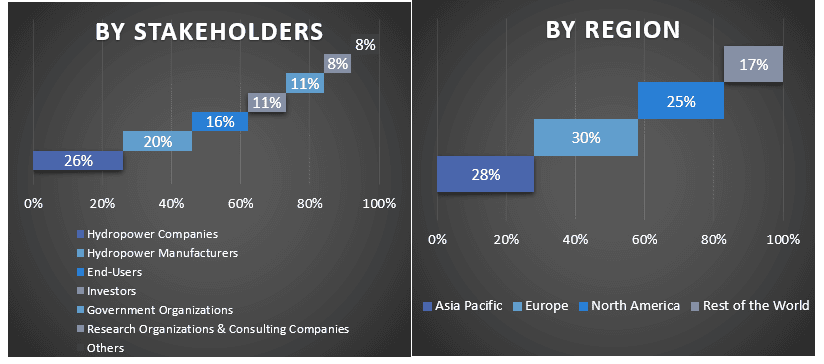
Инжиниринг рынка
Метод триангуляции данных был использован для завершения общей оценки рынка и получения точных статистических показателей для каждого сегмента и подсегмента глобального рынка гидроэнергетики. данные были разделены на несколько сегментов и подсегментов после изучения различных параметров и тенденций в областях собственности, мощности и технологий на глобальном рынке гидроэнергетики.
Основная цель глобального исследования рынка гидроэнергетики
В исследовании были точно определены текущие и будущие рыночные тенденции глобального рынка гидроэнергетики. Инвесторы могут получить стратегические данные, чтобы основывать свое усмотрение для инвестиций на качественном и количественном анализе, выполненном в исследовании. Текущие и будущие рыночные тенденции определили общую привлекательность рынка на региональном уровне, предоставив промышленным участникам платформу для эксплуатации неиспользованного рынка, чтобы воспользоваться преимуществом первопроходца. Другие количественные цели исследований включают:
- Анализ текущего и прогнозируемого размера рынка гидроэнергетики в стоимостном выражении (доллары США). Кроме того, анализ текущего и прогнозируемого размера рынка различных сегментов и подсегментов
- Сегменты в исследовании включают области собственности, мощности и технологий
- Определение и анализ нормативно-правовой базы для гидроэнергетической отрасли
- Анализ цепочки создания стоимости с участием различных посредников, а также анализ поведения клиентов и конкурентов отрасли
- Анализ текущего и прогнозируемого размера рынка гидроэнергетики для основного региона
- Основные страны регионов, изученные в отчете, включают Азиатско-Тихоокеанский регион, Европу, Северную Америку и остальной мир
- Профили компаний рынка гидроэнергетики и стратегии роста, принятые участниками рынка для поддержания устойчивости на быстрорастущем рынке
- Углубленный анализ отрасли на региональном уровне
Часто задаваемые вопросы Часто задаваемые вопросы
В1: Каков текущий размер рынка и потенциал роста рынка гидроэнергетики?
Q2: Каковы движущие факторы роста рынка гидроэнергетики?
Q3: Какой сегмент имеет наибольшую долю на рынке гидроэнергетики по форме собственности?
Q4: Каковы новые технологии и тенденции на рынке гидроэнергетики?
В5: Какой регион будет доминировать на рынке гидроэнергетики?
Связанные Отчеты
Клиенты, купившие этот товар, также купили




